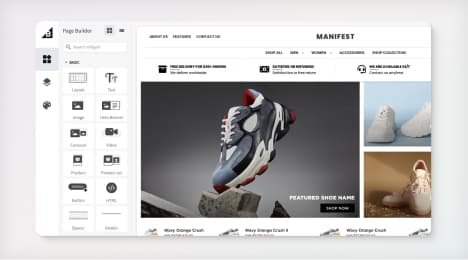
Watch Our Product Tour
See how BigCommerce helps you build and manage your online store with ease.
- Ecommerce Insights

6 Key Steps to Launch Your Online Store
Explore our Launch Foundations series to get your BigCommerce store up and running quickly.
BigCommerce helps growing businesses, enterprise brands, and everything in-between sell more online.
What is geo-targeting?
We’re in the middle of the digital age. From interaction on social media to screen sharing at work and, of course, buying online, we’re technology-dependent. This has given businesses immense opportunity. Thanks to things like SEO and social media, customer reach has been extended. You can now make your brand visible in places you’ve never heard of, and engage customers on the other side of the world.
This is great for many businesses, but not all. That delicious takeaway won’t stay warm if you’re shipping it to another country, and why would a plumber fly halfway round the world to fix a leaky pipe? These service-based businesses don’t need to be marketed to places they can’t get to; they need local, specific, targeted audiences. This is where geo-targeting comes in.
What is Geo-Targeting?
Geo-targeting - sometimes also known as local PPC - is the practice of delivering different content or advertisements based on their geographic locations. Instead of advertising to a broad audience, you can pinpoint local prospects who are far more likely to convert. These locations may be a country, state, city, zip code, IP address, organization, or other geographical area.
Why Does Marketing Need Geo-Targeting?
Research shows that location data is proven to make marketing campaigns up to 80% more effective. It’s a great way to provide customers with the ultimate tailored experience. People appreciate appropriate marketing - adverts that relate to what they are - or have been - looking for. This will ultimately lead to more online traffic and generate more business.
It’s an essential marketing tactic for businesses that rely heavily on footfall. Restaurants, retail shops, and general brick and mortar stores are defined by the number of customers who set foot in their shops. 85% of consumers still prefer buying in-store. But, the benefits of buying online have seen digital consumption soar at the expense of physical stores.
To combat this shift, geo-targeting identifies people who are realistically able to visit or order from businesses that depend on physical interaction. It saves time and prevents marketing campaigns chasing irrelevant or unreachable prospects.
How Does it Work?
There are many ways that geo-targeting can be used. The bottom line is, it’s predominantly in place to narrow customer reach and find realistic prospects.
1. Direct people in-store.
As mentioned, geo-targeting is most appropriate for businesses that depend on in-store experiences. The major challenge, however, is getting people to these stores. Geo-targeting is used to point them in the right direction.
Let’s think of an example. You’ve just received a marketing email from your favorite burger restaurant. Over the past few months, you’ve accumulated a number of loyalty points which now give you 50% off your next order. The catch, however, is that this can only be used in-store. The email clearly points you in the direction of the nearest restaurant, so it’s now up to you to go and see for yourself.
Here, geo-targeting has identified customers nearby, and directed them. If the prospect takes advantage of this deal it will increase footfall and improve engagement with that business.
2. Target those close enough.
Location marketing is all about getting your message to people in range. With geo-targeting you can set boundaries on how far your campaign reaches. If you’re an independent home appliance store that sells things like electrical goods, there’s not much point targeting prospects a hundred miles away.
Because your products aren’t necessarily unique, it’s very likely that another store within this boundary sells exactly the same stuff. Instead of marketing to people who have access to another store, you can focus more on realistic prospects who actually need your service. Master this and you can expect to see a spike in sales.
This can also be done by excluding yourself from certain areas, and it’s not always based on distance. You may market, let’s say, free alternatives to Facebook Workplace. The neighboring area may be opposed to the technology, for religious or social reasons - so it’s of no use to you and your product. By ruling out this area, your marketing is far more streamlined and direct.
3. Match data.
Geo-targeting is great for personalizing customer experience. One of its most valuable assets is its ability to match product data with customer data. In other words, it can match a product’s location with the shopper’s location and behavior.
It’s all to do with customization. Here’s an example: If a customer is browsing online for sales software, geo-targeting has the capacity to only show them what is available in their nearest store.
You may have just received a marketing email recommending the ‘the best file sharingproducts to boost sales.’ Effective geo-targeting identifies which of these products is in the nearest store, and removes from the email those that aren’t.
This customized approach keeps the customer on side. Without this personalization, that customer may read the email, head to the store with a clear idea of what they want, only to get there and find that the item is sold out. Geo-targeting puts two and two together: it pairs what’s available in-store with what customers want. If it’s not there, there’s no point in marketing it.
Where Can You Use Geo-Targeting?
Google Ads is the most popular place to use geo-targeting. You can specifically choose the locations and areas in which you want to market. Google gives you an option to type in a country, state, or zip-code. And, through its advanced features you can even carefully place a radius over the area of the map you want to target.
Social media platforms, like Facebook and Twitter, are also increasingly effective when it comes to geo-targeting - it’s all about finding one that works best for your business.
BigCommerce helps growing businesses, enterprise brands, and everything in-between sell more online.
Start growing your ecommerce business even faster.
High-volume or established business? Request a demo